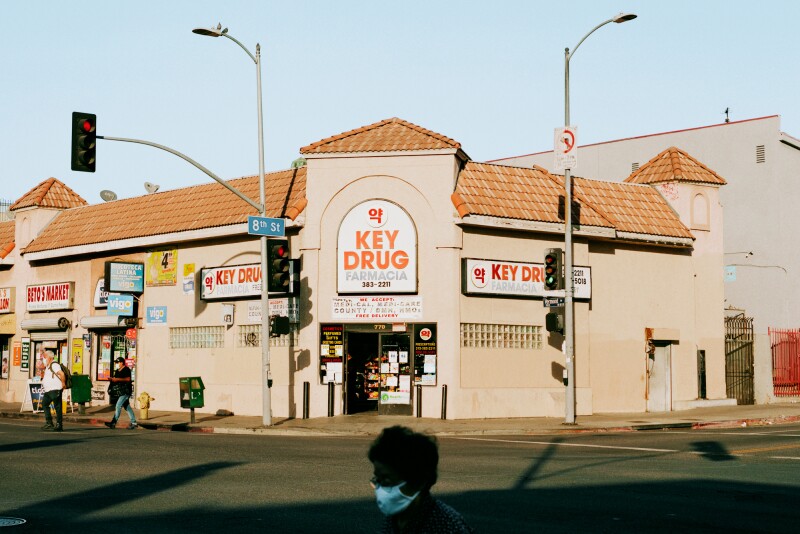Spanning roughly three square miles, Los Angeles’s Koreatown is home to the largest population of ethnically Korean people outside of Asia. Here, among blocks of strip malls, visitors can find storefronts dedicated to day spas, hanbok (traditional Korean dress), and some of the best Korean food in the nation, with restaurants serving such homey dishes as seolleongtang (ox bone soup), gamjatang (pork neckbone soup), and, of course, Korean barbecue. That’s to say nothing of the neighborhood’s animated mix of nightclubs, karaoke bars, and 24-hour businesses.
In October 2020, photographer Emanuel Hahn moved from New York to Los Angeles to pursue a career in the film industry. Looking for a way to feel creatively stimulated during pandemic lockdowns and also help promote small businesses in the area, Hahn began visiting and photographing Koreatown on a daily basis. The result is Koreatown Dreaming: Stories & Portraits of Korean Immigrant Life (Running Press, 2023), which covers enclaves in L.A. as well as Honolulu, Dallas, New York, New Jersey, and Annandale, Virginia. I spoke with Hahn to learn more about what Koreatowns mean to him.

From left: High Society was the first Korean custom tailor shop in the area. The store counts A-list celebrities and film studios among its regular clientele; High Society owner David Lim poses with his mother.
Photos by Emanuel Hahn
When did you first visit Koreatown in Los Angeles?
It was in 2011, the summer between my freshman and sophomore years of college. [My friends and I] did all of the L.A. things, but visiting Koreatown was just amazing. I remember thinking, “Wow, there’s so much food!” I also found that it reminded me a lot of Korea; specifically, my parents’ hometown in Daegu. Koreatown felt like it hadn’t moved on from the 1990s. Seeing a place so locked in time, I don’t know, it had this . . . nostalgic feeling.
What was the inspiration for this book?
I started the project late in 2020. I had this hypothesis that with the twin forces of gentrification and COVID, there might be a lot of businesses struggling to stay open. I was thinking of how owners emigrated from Korea in the 1980s and 1990s when L.A.’s Koreatown was first forming, and now they were approaching retirement age during this difficult period. Even in five years, Koreatown will look very different from what it is now. [The book] is a way to honor these business owners and tell their stories before they are gone.

As one of the city’s most diverse neighborhoods, L.A.'s Koreatown is also home to a sizable Latino population.
Photo by Emanuel Hahn
What did you learn about Koreatowns while you were taking portraits and interviewing people?
I think I underestimated how much love there was for Koreatowns all across the country, especially from people outside the community. Koreatowns are often the first entry point for non-Koreans to meet Korean culture—whether through food, music, or otherwise—and it was clear that in various cities, people were glad that Koreatowns existed near them. While many immigrants were focused on building businesses, they inevitably opened up a path to share their culture with other Americans.

From left: Sang Heon Lee and Enny Lee are the owners of Kang Nam restaurant, a Koreatown favorite that has been open for more than 40 years; banchan, or side dishes, are served with almost every meal in Korean culture.
Photos by Emanuel Hahn
What do you love to photograph the most?
I love design. I love art. But for me, I think it all goes back to identity. Like, who are we? Through my work, I explore who I am as a person—and the tensions I feel as an Asian American living in the United States.

From left: At Music Plaza, which Seon Hee Chon founded in 1992, customers can peruse Korean pop albums; L.A.'s Koreatown has the highest concentration of 24-hour businesses in the USA.
Photos by Emanuel Hahn
You’re a third-culture kid, meaning that you grew up in a lot of different countries as a child. What was that like for you?
I grew up in South Korea, Singapore, and Cambodia and moved to New York City in 2010 for college. I think it’s a bit different from being an Asian American person growing up in the States. Third-culture kids experience constant movement. In my case, I moved every four years. You’re constantly having to readjust to a new situation. You gather so many perspectives along the way.

From left: In 1980, Koreatown was officially recognized as a neighborhood by L.A. County; Audrey Jang founded Chunju Han-Il Kwan, a homey Korean diner, in 1992. One of its specialities is budae jjigae, or army base stew. Invented during the Korean War, this fusion dish features American products such as Spam and baked beans.
Photos by Emanuel Hahn
In the introduction of your book, you mention that no matter where you’ve lived, you always felt like Koreatowns were your home. Why?
When I moved to New York, I met a lot of Korean Americans from all over the country. There were so many things that revolved around having this space [Koreatown] that we could keep returning to and reinforce our identity as Korean people. Sometimes as a Korean person you crave a certain Korean food, and you would go to Koreatown to get it. That’s beautiful to me.











